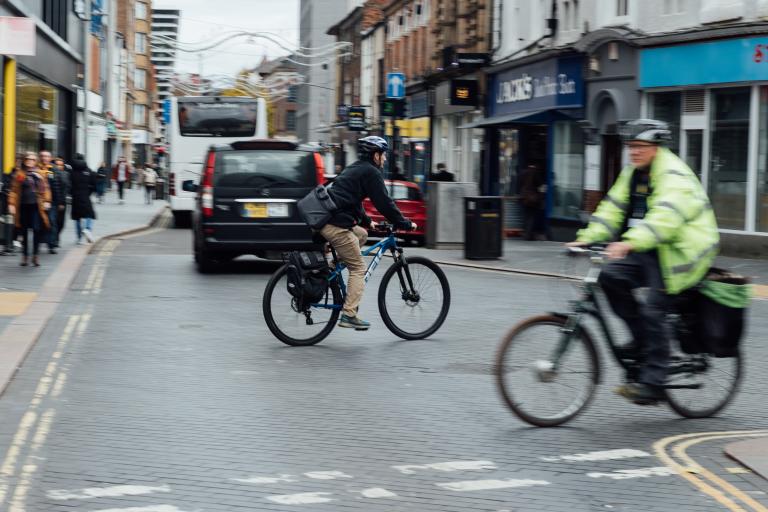
Changes to The Highway Code designed to enhance safety for all road-users – particularly those most at risk – are set to come into effect from 29 January 2022, as the government continues to build back safer.
If approved by Parliament, a hierarchy of road-users will be introduced this weekend, ensuring quicker or heavier modes of travel have the greatest responsibility to reduce the danger or threat they may pose to others on the road.
Cyclists will also receive fresh guidance to ride in the centre of a lane on quieter roads, in slower-moving traffic and at the approach to junctions in order to make themselves as clearly visible as possible. They’ll also be reminded they can ride 2 abreast – as has always been the case and which can be safer in large groups or with children – but they must be aware of drivers behind them and allow them to overtake if it is safe to do so.
Meanwhile, motorists will be encouraged to adopt the so-called ‘Dutch Reach’ (as shown), opening the door next to them with the opposite hand so they look over their shoulder, meaning they’re less likely to injure passing cyclists and pedestrians.
The government’s award-winning THINK! campaign will soon launch a communications drive, backed by over £500,000 in funding, raising awareness of the changes and ensuring road-users across the country understand their responsibilities. The campaign will run across radio and social media channels, with further campaign activity to follow later in the summer.
The new updates are advisory, so non-compliance will not result in a fine.
Roads Minister Baroness Vere said:
I’m proud to say we have some of the safest roads in the world, but I’m determined to make them safer still for everyone.
These updates to The Highway Code will do just that by bringing the rules into the 21st century, encouraging people to respect and consider the needs of those around them, and ensuring all road-users know the rules of the road.
The government initially announced the detail of the incoming updates to The Highway Code to national media last summer. They follow a public consultation where nearly 21,000 people submitted their views, with the majority supporting every single one of the changes coming into force this weekend.
The changes seek to improve the safety of those most at risk on our roads. Everyone has an equal right to use the road and, likewise, everyone has a shared responsibility to behave in a safe and considerate manner.
The Department for Transport (DfT) engaged with key stakeholders while developing the changes, and a Highway Code Communications Working Group has been established with industry working alongside government to raise awareness.
The changes will be made to the digital version of The Highway Code this weekend, followed by an update to the printed version which is due to be published in April 2022. See an explanation of 8 of the most significant changes.
Active Travel Commissioner for England, Chris Boardman, said:
It shouldn’t take bravery to cross a road or ride to school with kids, but sometimes it feels that way. These changes to the Highway Code clarify our responsibility to each other and simply reinforce what good road users already do. This refresh does more than offer guidance though, it makes our towns, cities and villages nicer places to live.
The government recognises the importance of The Highway Code keeping pace with the way in which people get about, as well as with changes to transport infrastructure. For example, the updates recognise new cycle-friendly signals and cycle junctions, so people know how to use modern carriageways. Cyclists are also encouraged to consider training in order to have the skills, knowledge and confidence to ride safely and responsibly on the road.
Last year, the Transport Secretary provided £18 million for Bikeability cycle training for children and families.
Emily Cherry, Chief Executive at The Bikeability Trust, said:
We welcome these changes to The Highway Code because they encourage all road users to share their space, whilst protecting the most vulnerable.
Millions of children in England have been taught how to interact positively with other road users, thanks to Bikeability cycle training. We are pleased the updated Highway Code will now reflect the lessons we already teach children and help the next generation grow up as confident, competent and courteous road users.
RAC Head of Roads Policy, Nicholas Lyes, said:
These major changes to The Highway Code should make the roads safer for the most vulnerable road users, in particular, those walking and cycling, so are to be welcomed. But it’s vitally important that all road users – especially drivers – take the time to fully understand what’s new as some of the changes are a significant departure from what’s gone before. For instance, drivers turning into a road should now give way to any pedestrians waiting to cross.
As we look towards a net zero future, safer roads will encourage more and more people to travel by foot, bike or public transport, helping reduce congestion and emissions. Improvements to road safety measures will also lead to fewer road traffic collisions, not only saving lives but also the billions of pounds spent every year on dealing with such collisions.
As part of their work to improve road safety even further, DfT also recently announced plans to change the laws around using handheld mobile phones while driving. They will be made stricter later this year, making virtually any use of them behind the wheel illegal, with those caught breaking the law potentially facing 6 penalty points and a £200 fine.
